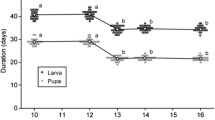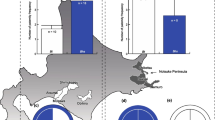Abstract
In natural populations of golden egg bugs ( Phyllomorpha laciniata), females lay eggs on plants where they develop unattended, or on conspecifics, where they remain firmly glued until the nymphs hatch and start an independent life. Mortality rates among eggs laid on plants are higher than among eggs carried by adults. Because females cannot lay eggs on themselves, in order to improve offspring survival, they have to lay eggs on other individuals. Two hypotheses have been proposed to explain egg carrying: (1) the mating pair intraspecific brood parasitism hypothesis suggests that females dump eggs on copulating pairs, and (2) the paternal care hypothesis suggests that the system is driven mainly by males accepting eggs to improve the survival rates of their own offspring. Our data from the field show that 77% of the eggs are carried by males, because more males than females carry eggs, and because males carry a greater number of eggs. In addition, we show that mating males carry more recently laid eggs than single males. These results support the view that egg carrying is performed predominantly by males and that eggs are laid on males by their current mating partner, probably between repeated copulations. Males are likely to accept eggs, despite intermediate levels of paternity, because they cannot discriminate in favour of their own eggs, because rejected eggs will face 97% mortality rates on plants, and because they do not suffer mating costs when they carry eggs. However, females carry 23% of the eggs, but no differences in egg carrying have been found between mating and single females, suggesting that this is not the result of egg dumping while females are copulating. Egg carrying by females could reflect low levels of intraspecific parasitism, which is likely to reflect the low rate of successful attempts by egg-laying females who try to oviposit on other conspecifics rather indiscriminately, in an effort to improve the survival of their offspring.



Similar content being viewed by others
References
Åhlund M, Andersson M (2001) Female ducks can double their reproduction. Nature 414:600–601
Birkhead TR, Pellatt J, Hunter FM (1988) Extra-pair copulation and sperm competition in the zebra finch. Nature 334:60–62
Brockman HJ (1993) Parasitizing conspecifics: comparisons between Hymenoptera and birds. Trends Ecol Evol 8:2–4
Brown CR (1984) Laying eggs in a neighbor's nest: benefit and cost of colonial nesting in swallows. Science 224:518–519
Brown CR, Brown MB (1998) Fitness components associated with alternative reproductive tactics in cliff swallows. Behav Ecol 9:158–171
Burke T, Davies NB, Bruford MW, Hatchwell BJ (1989) Parental care and mating behaviour of polyandrous dunnocks Prunella modularis related to paternity by DNA fingerprinting. Nature 338:249–251
Clutton-Brock TH (1991) The evolution of parental care. Princeton University Press, Princeton, N.J.
Dickinson JL (1986) Prolongued mating in the milkeweed leaf beetle Labidomera clivicollis clivicollis (Coleoptera: Chrysomelidae): a test of the "sperm-loading" hypothesis. Behav Ecol Sociobiol 18:331–338
Dixon A, Ross D, O'Malley SLC, Burke T (1994) Paternal investment inversely related to degree of extra-pair paternity in the reed bunting. Nature 371:698–700
Eberhard WG (1975) The ecology and behavior of a subsocial pentatomid bug and two scelionid wasps: strategy and counterstrategy in a host and its parasites. Smithson Contrib Zool 205:1–39
Field J (1992) Intraspecific parasitism as an alternative reproductive tactic in nest-building wasps and bees. Biol Rev 67:79–126
García-González F (2002) La evolución del transporte de huevos en Phyllomorpha laciniata (Het., Coreidae): una aproximación comportamental, fisiológica y molecular para explicar su significado adaptativo en machos y hembras. PhD Thesis, Universidad Complutense de Madrid
García-González F, Núñez Y, Ponz F, Roldán ERS, Gomendio M (2003) Sperm competition mechanisms, confidence of paternity, and the evolution of paternal care in the golden egg bug Phyllomorpha laciniata. Evolution (in press)
Gomendio M, Reguera P (2001) Egg carrying in the golden egg bug ( Phyllomorpha laciniata): parental care, parasitism, or both? Reply to Kaitala et al. Behav Ecol 12:369–373
Hardin MR, Tallamy DW (1992) Effect of predators and host phenology on the maternal and reproductive behaviors of Gargaphia lace bugs (Hemiptera: Tingidae). J Insect Behav 5:117–192
Houston AI, McNamara JM (2002) A self-consistent approach to paternity and parental effort. Philos Trans R Soc Lond B 357:351–362
Hughes C (1998) Integrating molecular techniques with field methods in studies of social behavior: a revolution results. Ecology 79:383–399
Jennions MD, Petrie M (1997) Variation in mate choice and mating preferences: a review of causes and consequences. Biol Rev 72:283–327
Kaitala A (1996) Oviposition on the back of conspecifics: an unusual reproductive tactic in a coreid bug. Oikos 77:381–389
Kaitala A (1998) Is egg carrying attractive? Mate choice in the golden egg bug (Coreidae, Heteroptera). Proc R Soc Lond B 265:779–783
Kaitala A, Miettinen M (1997) Female egg dumping and the effect of sex ratio on male egg carrying in a coreid bug. Behav Ecol 8:429–432
Kaitala A, Härdling R, Katvala M, Macías Ordóñez R, Miettinen M (2001) Is nonparental egg carrying parental care? Behav Ecol 12:367–368
Kraak SBM, Weissing FJ (1996) Female preference for nests with many eggs: a cost-benefit analysis of female choice in fish with paternal care. Behav Ecol 7:353–361
Miettinen M, Kaitala A (2000) Copulation is not a prerequisite to male reception of eggs in the golden egg bug Phyllomorpha laciniata (Coreidae; Heteroptera). J Insect Behav 13:731–740
Mineo G (1984) Notizie biologiche su Phyllomorpha laciniata (Vill.) (Rhynchota, Het., Coreidae). Phytophaga 2:117–132
Møller AP, Birkhead TR (1993) Cuckoldry and sociality: a comparative study of birds. Am Nat 142:118–140
Müller JK, Eggert A-K (1989) Paternity assurance by "helpful" males: adaptations to sperm competition in burying beetles. Behav Ecol Sociobiol 24:245–249
Müller JK, Eggert A-K, Dressel J (1990) Intraspecific brood parasitism in the burying beetle, Necrophorus vespilloides (Coleoptera: Silphidae). Anim Behav 40:491–499
Petrie M, Møller AP (1991) Laying eggs in others' nests: intraspecific brood parasitism in birds. Trends Ecol Evol 6:315–320
Reguera P (1999) Cuidado parental en Phyllomorpha laciniata (Het.: Coreidae): implicaciones para la evolución del cuidado por parte de machos y hembras. PhD Thesis, Universidad Complutense de Madrid
Reguera P, Gomendio M (1999) Predation costs associated with parental care in the golden egg bug Phyllomorpha laciniata (Heteroptera: Coreidae). Behav Ecol 10:541–544
Reguera P, Gomendio M (2002) Flexible oviposition behavior in the golden egg bug ( Phyllomorpha laciniata) and its implications for offspring survival. Behav Ecol 13:70–74
Ridley M (1978) Paternal care. Anim Behav 26:904–932
Ridley M, Rechten C (1981) Female sticklebacks prefer to spawn with males whose nests contain eggs. Behaviour 76:152–161
Sheldon BC (2002) Relating paternity to paternal care. Philos Trans R Soc Lond B 357:341–350
Simmons LW (2001) Sperm competition and its evolutionary consequences in the insects. Princeton University Press, Princeton
Simmons LW, Siva-Jothy MT (1998) Sperm competition in insects: mechanisms and the potential for selection. In: Birkhead TR, Møller AP (eds) Sperm competition and sexual selection. Academic Press, San Diego, pp 341–434
Smith RL (1979a) Paternity assurance and altered roles in the mating behaviour of a giant water bug, Abedus herberti (Heteroptera: Belostomatidae). Anim Behav 27:716–725
Smith RL (1979b) Repeated copulation and sperm precedence: paternity assurance for a male brooding water bug. Science 205:1029–1031
Smith RL (1980) Evolution of exclusive postcopulatory paternal care in the insects. Fla Entomol 63:65–77
Smith RL (1997) Evolution of paternal care in the giant water bugs (Heteroptera: Belostomatidae). In: Choe JS, Crespi BJ (eds) The evolution of social behavior in insects and arachnids. Cambridge University Press, Cambridge, pp 116–149
Sokal RR, Rohlf FJ (1981) Biometry. Freeman, New York
Tallamy DW, Denno RF (1981) Maternal care in Gargaphia solani (Hemiptera: Tingidae). Anim Behav 29:771–778
Tallamy DW, Wood TK (1986) Convergence patterns in subsocial insects. Annu Rev Entomol 31:369–390
Trivers RL (1972) Parental investment and sexual selection. In: Campbell R (ed) Sexual selection and the descent of man. Heinemann, London, pp 136–179
Westneat DF, Sargent RC (1996) Sex and parenting: the effects of sexual conflict and parentage on parental strategies. Trends Ecol Evol 11:87–91
Westneat DF, Sherman PW (1993) Parentage and the evolution of parental behavior. Behav Ecol 4:66–77
Whittingham LA, Taylor PD, Robertson RJ (1992) Confidence of paternity and male parental care. Am Nat 139:1115–1125
Williams GC (1966) Natural selection, the cost of reproduction, and a refinement of lack's principle. Am Nat 100:678–690
Wilson EO (1971) The insect societies. Belknap, Cambridge, Mass
Wright J (1998) Paternity and paternal care. In: Birkhead TR, Møller AP (eds) Sperm competition and sexual selection. Academic Press, San Diego, pp 117–145
Yom-Tov Y (1980) Intraspecific nest parasitism in birds. Biol Rev 55:93–108
Zeh DW, Smith RL (1985) Paternal investment by terrestrial arthropods. Am Zool 25:785–805
Zink AG (2000) The evolution of intraspecific brood parasitism in birds and insects. Am Nat 155:395–405
Acknowledgements
For helpful assistance with field work, we thank Francisco Cabrero, Jose Antonio Blanco, Eva Banda and Beatriz Sanz. Thanks also to Piedad Reguera for comments on an earlier draft of this manuscript. We are grateful to the constructive comments made by the referees. While working on this project, F.G.-G. enjoyed a PhD Fellowship from the Ministry of Science and Technology (FP97-7234207). The research project was funded by grants from the Ministry of Science and Technology (PB96-0880 and REN2000-1470). The experiments were carried out according to the legal and ethical standards of Spanish regulations.
Author information
Authors and Affiliations
Corresponding author
Additional information
Communicated by L. Simmons
Rights and permissions
About this article
Cite this article
García-González, F., Gomendio, M. A field test of the intraspecific brood parasitism hypothesis in the golden egg bug ( Phyllomorpha laciniata). Behav Ecol Sociobiol 53, 332–339 (2003). https://doi.org/10.1007/s00265-002-0566-z
Received:
Revised:
Accepted:
Published:
Issue Date:
DOI: https://doi.org/10.1007/s00265-002-0566-z




